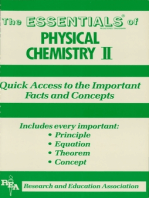Technical Paper - Heat Capacity Ratio
Technical Paper - Heat Capacity Ratio
Uploaded by
datUPstudentdoeCopyright:
Available Formats
Technical Paper - Heat Capacity Ratio
Technical Paper - Heat Capacity Ratio
Uploaded by
datUPstudentdoeOriginal Description:
Copyright
Available Formats
Share this document
Did you find this document useful?
Is this content inappropriate?
Copyright:
Available Formats
Technical Paper - Heat Capacity Ratio
Technical Paper - Heat Capacity Ratio
Uploaded by
datUPstudentdoeCopyright:
Available Formats
Physics 73.
1: Elementary Physics Laboratory III
University of the Philippines Diliman, Quezon City, Philippines
1
Heat Capacity Ratio
Frank Perry Rubia
1
, Joshua Angelo Encarnacion
2
, Mikoel Miclat
3
, and Manuel Matthew Chanco V
4*
1
National Institute of Geological Sciences, University of the Philippines-Diliman, Diliman, Quezon City
2
Department of Geodetic Engineering & Training Center for Applied Geodesy and Photogrammetry, University of
the Philippines-Diliman, Diliman, Quezon City
3
Department of Geodetic Engineering & Training Center for Applied Geodesy and Photogrammetry, University of
the Philippines-Diliman, Diliman, Quezon City
4
Department of Chemical Engineering, University of the Philippines-Diliman, Diliman, Quezon City
*Corresponding author: mmchanco5@yahoo.com
Abstract
This experiment was done to understand the concepts of heat capacity and heat
capacity ratio. Rchardts method was used to determine the heat capacity ratio of
air using simple harmonic motion and damped oscillation concepts. A best-fit line
of the T
-2
vs. y
o
-1
plot was determined and the slope and y-intercept of this line
was used to calculate the heat capacity ratio and the damping parameter,
respectively. The data gave a good fit, with an R
2
value of 0.997. The calculated
heat capacity ratio only deviated by 0.67% from the theoretical.
Keywords: heat capacity ratio, Rchardt method, adiabatic expansion, ideal gas,
damped oscillation
Introduction
The heat capacity of an object is the heat required to raise an objects temperature by one degree Celsius.
Determining this is essential in calculating for the change in internal energy of gases if subjected to varying
temperatures.
For ideal gases, its heat capacity at constant volume and at constant pressure is related by the ratio
where C
p
and C
v
are the heat capacity of a gas at constant pressure and constant volume, respectively. Theoretically,
the heat capacity ratio of an ideal diatomic gas is =1.4. [1]
Eduard Rchardt, a German physicist, designed a method to determine the heat capacity ratio of a diatomic gas
experimentally. In his experiment, Rchardt put a constant amount of gas in a container by sealing it with a piston
on top. The piston was given a small vertical downward displacement which caused to the piston to bounce and
oscillate as the set-up creates an air cushion that opposes the vertical displacement. The oscillation has a period that
is dependent on the heat capacity ratio of the gas and so, he was able to compute for that ratio.
The height of the piston in the set-up was described using Newtons second law yielding to the equation
where m is the mass of the piston, P is the pressure of the gas inside the container, A is the cross-sectional area of
the piston, g = 9.81 m/s
2
is the acceleration due to gravity and P
atm
= 101325 Pa is the atmospheric pressure. The gas
was given quick changes in volume so it can be assumed that there is no heat transferred in the system. [2] A process
which involves almost no transfer of heat is said to be adiabatic and the relationship between its initial and final
volumes and pressures is characterized by
Considering this equality and the under damped oscillation that the piston experiences as friction develops between
it and the containers walls, it can be incorporated to the previous equation and come up with the relationship
between its period and the heat capacity ratio of the gas given by
where the new variables T and b are the period of oscillation and damping parameter, respectively. [2] Using this
equation which relates the slope of the T
-2
vs. y
0
-1
plot and heat capacity ratio, the heat capacity ratio can be obtained
through the following relationship
(1)
(2)
(3)
(4)
Physics 73.1: Elementary Physics Laboratory III
University of the Philippines Diliman, Quezon City, Philippines
2
Methodology
The objective of this experiment is to determine the heat capacity ratio of air using Rchardts method. The
materials used were a heat engine apparatus, and a Vernier LabQuest with gas pressure sensor. Figure 1 shows the
apparatus used in the experiment.
Figure 1. Gas Enginer Apparatus (left), Vernier LabQuest (right)
At first, the Vernier LabQuest was setup by choosing a duration of 5 seconds with a sampling of 500 samples
per second in the Sensors menu. The experiment was done by setting an initial height of the piston, y
0
, then lightly
tapping the piston to compress the air inside. A pressure versus time graph was obtained in the Vernier LabQuest
which exhibits damped oscillation. The oscillating part of the graph was isolated by zooming in and the period of
oscillation, T, was determined by measuring the time interval for each peak. To make precise measurements, the
time interval for several peaks, about four to six, were averaged. Three trials were done and the procedure was
repeated for four more values of y
0
.
(5)
Physics 73.1: Elementary Physics Laboratory III
University of the Philippines Diliman, Quezon City, Philippines
3
Results and Discussion
After obtaining the data, a plot of T
-2
vs y
0
-1
was generated. The values of the period were averaged from the
three trials. The following figure shows the plot.
Figure 2. T
-2
vs y0
-1
plot. . The data obtained was fitted assuming that the piston movement behaves as damped oscillating
From Figure 2, it can be seen that the experiment gave relatively good results because of the good fit (R
2
=
0.9973). An increasing trend can also be observed from the graph as the initial height increases which confirms the
direct proportionality between the height and the period of oscillation from equation 4. From equation 5, the
experimental heat capacity ratio of air can be calculated, which is equal to 1.409. The damping parameter can also
be calculated from the y-intercept using equation 4, which is equal to 5.607 kg/s. If the piston movement is assumed
to be a simple harmonic motion, then the data must be fitted to a different equation.
Equation 6 describes a simple harmonic motion where is the angular frequency. From the data, the angular
frequency can be obtained with the following relationship.
To calculate the heat capacity ratio assuming simple harmonic motion, a vs y
0
-1/2
plot must be made from the
data and fitted.
Figure 3. vs y0
-1/2
plot. The data obtained was fitted assuming that the piston movement behaves as simple harmonic motion
y = 86.0897x - 162.5563
R = 0.9973
600
650
700
750
800
850
900
950
1000
10 11 12 13 14
1
/
T
2
1/y
0
y = 63.6524x - 35.1506
R = 0.9973
170
175
180
185
190
195
200
3.2 3.3 3.4 3.5 3.6 3.7
1/y
0
1/2
(6)
(7)
Physics 73.1: Elementary Physics Laboratory III
University of the Philippines Diliman, Quezon City, Philippines
4
Figure 2 also shows a good fit and same pattern if the piston movement was assumed to behave as simple
harmonic motion. However, the calculated heat capacity ratio is equal to 1.680 which deviates from the theoretical
value by 20%. This is because by assuming simple harmonic motion, the friction effect (damping) of the wall on the
piston was neglected. Hence, the behavior of the piston movement is confirmed as damped oscillating.
Conclusion
The heat capacity ratio was calculated by Rchardts method. The behavior of the piston movement is damped
oscillation and a T
-2
vs. y
0
-1
plot was generated. A best fit line was fitted to the data to calculate for the heat capacity
ratio. Based on the results, Rchardts method of experimentally determining the heat capacity ratio is reliable
because of the very low percent deviation calculated. Also, the direct proportionality between the initial height of the
piston and the period of oscillation was confirmed through the experiment.
Acknowledgements
This experiment was done with the help of lab instructor, Mr. Lean Dasallas.
References
1. Hugh D. Young, Roger A. Freedman and Lewis Ford, Sears and Zemanskys University Physics with Modern
Physics. 13
th
Edition, chapter 19. Addison Wesley, Inc. 2008.
2. Lab Manual Authors, "Experiment 4: Heat Capacity Ratio," Physics 73.1 Laboratory Manual 1
st
Semester A.Y.
2014-2015. pp 3-6, 2014.
Physics 73.1: Elementary Physics Laboratory III
University of the Philippines Diliman, Quezon City, Philippines
5
Division of Labor
Manuel Matthew Chanco V
o Author
o Results and Discussion
Joshua Angelo Encarnacion
o Introduction
Mikoel Miclat
o Abstract
o Methodology
Frank Perry Rubia
o Conclusion
Everyone participated during the experiment.
You might also like
- Case Study Shack Shack IPODocument36 pagesCase Study Shack Shack IPOtushar shivan100% (2)
- Formal Report On Partial Molar Volume ExperimentDocument9 pagesFormal Report On Partial Molar Volume ExperimentdatUPstudentdoe100% (5)
- The Perfect Gas Expansion Experiment (TH 11)Document22 pagesThe Perfect Gas Expansion Experiment (TH 11)Muhammad Haidharul Irfan100% (22)
- Acetone DiffusionDocument15 pagesAcetone DiffusionArmaan Hussain40% (5)
- 1GP1 Dynamics - Lab ManualDocument8 pages1GP1 Dynamics - Lab ManualCogCoilNo ratings yet
- Wintel ReportDocument1 pageWintel ReportMS Nag100% (2)
- Creep of PolyurethaneDocument33 pagesCreep of PolyurethaneubdubNo ratings yet
- Entropy: Project PHYSNET Physics Bldg. Michigan State University East Lansing, MIDocument6 pagesEntropy: Project PHYSNET Physics Bldg. Michigan State University East Lansing, MIEpic WinNo ratings yet
- Determination of Heat Capacity Ratio of Air: Using The Adiabatic Expansion MethodDocument4 pagesDetermination of Heat Capacity Ratio of Air: Using The Adiabatic Expansion MethodMichael Jemziel GulayNo ratings yet
- Research Inventy: International Journal of Engineering and ScienceDocument5 pagesResearch Inventy: International Journal of Engineering and ScienceinventyNo ratings yet
- Physics Project C-12thDocument18 pagesPhysics Project C-12thPratyush GuptaNo ratings yet
- Specific Heat RatioDocument5 pagesSpecific Heat RatioTj RentoyNo ratings yet
- Laporan Suwandy Effendy Unit 1 (FINISH)Document39 pagesLaporan Suwandy Effendy Unit 1 (FINISH)maharani fauzia annurNo ratings yet
- 1-Le CorreDocument7 pages1-Le CorreJose Luis RattiaNo ratings yet
- Specific Heat RatioDocument5 pagesSpecific Heat RatioPaolo QuinteroNo ratings yet
- Title of ExperimentDocument17 pagesTitle of ExperimentSiti FatimahNo ratings yet
- Non-Conventional Approaches To Generating Lift. General Physical AspectsDocument10 pagesNon-Conventional Approaches To Generating Lift. General Physical Aspectsmkrinker1296No ratings yet
- The Analogy Between Heat and Mass Transfer in Low Temperature Crossflow EvaporationDocument11 pagesThe Analogy Between Heat and Mass Transfer in Low Temperature Crossflow EvaporationPIZZA MOZZARELLANo ratings yet
- Lab 3 Report Fins RedoDocument3 pagesLab 3 Report Fins RedoWestley GomezNo ratings yet
- F4 ExperimentsDocument52 pagesF4 ExperimentsKiTTy94% (16)
- CHE309 Report#1Document14 pagesCHE309 Report#1rawxNo ratings yet
- Experiment 4 (Determination of Ratio of Heat Capacity)Document18 pagesExperiment 4 (Determination of Ratio of Heat Capacity)Azman Karim100% (2)
- Name: Anil Rochester ID#: Date: Lab Partners: Lab Instructors: Lab #Document9 pagesName: Anil Rochester ID#: Date: Lab Partners: Lab Instructors: Lab #Nyree RobinsonNo ratings yet
- A Micro-Convection Model For Thermal Conductivity of NanofluidsDocument7 pagesA Micro-Convection Model For Thermal Conductivity of NanofluidsratchagarajaNo ratings yet
- Etd Chapt 6Document69 pagesEtd Chapt 6Miruna PetriaNo ratings yet
- Structural Relaxion Glass Transition TempDocument13 pagesStructural Relaxion Glass Transition TempMetin TülümenNo ratings yet
- Lab 04 - The Simple PendulumDocument5 pagesLab 04 - The Simple PendulummusabNo ratings yet
- Thermo 2 NewDocument6 pagesThermo 2 NewmubsanNo ratings yet
- Thermal PhysicsDocument17 pagesThermal PhysicsAdi InpanNo ratings yet
- Thermodynamics and Efficiency of A Heat EngineDocument2 pagesThermodynamics and Efficiency of A Heat EngineMarc CastroNo ratings yet
- Science Reaction Rate Practica1Document9 pagesScience Reaction Rate Practica1Tauhir EdwardsNo ratings yet
- Cain 1997Document9 pagesCain 1997AWAISNo ratings yet
- Introduction To Chemical Engineering Thermodynamics: Third ClassDocument12 pagesIntroduction To Chemical Engineering Thermodynamics: Third ClassabdulqadirNo ratings yet
- Lab Report PVT - SolahDocument34 pagesLab Report PVT - SolahSo Lah MusaNo ratings yet
- (3) Temperature Distribution on Pin Fin Heatsinks (柱狀陣列熱沉溫度分佈) - 2017Document8 pages(3) Temperature Distribution on Pin Fin Heatsinks (柱狀陣列熱沉溫度分佈) - 2017king92985No ratings yet
- Properties Measurement-PVT) PDFDocument7 pagesProperties Measurement-PVT) PDFNadzratul NazirahNo ratings yet
- How To Write A Physics Lab Report - Revise PDFDocument18 pagesHow To Write A Physics Lab Report - Revise PDFTural UsubovNo ratings yet
- Determination of The Heat Capacity RatioDocument6 pagesDetermination of The Heat Capacity RatioNhi TạNo ratings yet
- Numerical Simulations of The Dynamics and Heat Transfer Associated With A Single Bubble in Subcooled Pool BoilingDocument15 pagesNumerical Simulations of The Dynamics and Heat Transfer Associated With A Single Bubble in Subcooled Pool Boiling9thwonder10No ratings yet
- Phy11l A4 E201Document8 pagesPhy11l A4 E201nadaynNo ratings yet
- Reading Modulatet DSC Termochimica Acta 1994Document13 pagesReading Modulatet DSC Termochimica Acta 1994pedroNo ratings yet
- Physico-Chemistry of Solid-Gas Interfaces: Concepts and Methodology for Gas Sensor DevelopmentFrom EverandPhysico-Chemistry of Solid-Gas Interfaces: Concepts and Methodology for Gas Sensor DevelopmentNo ratings yet
- Treatise on Irreversible and Statistical Thermodynamics: An Introduction to Nonclassical ThermodynamicsFrom EverandTreatise on Irreversible and Statistical Thermodynamics: An Introduction to Nonclassical ThermodynamicsRating: 1 out of 5 stars1/5 (1)
- Pressure, Heat and Temperature - Physics for Kids - 5th Grade | Children's Physics BooksFrom EverandPressure, Heat and Temperature - Physics for Kids - 5th Grade | Children's Physics BooksNo ratings yet
- “Foundations to Flight: Mastering Physics from Curiosity to Confidence: Cipher 4”: “Foundations to Flight: Mastering Physics from Curiosity to Confidence, #4From Everand“Foundations to Flight: Mastering Physics from Curiosity to Confidence: Cipher 4”: “Foundations to Flight: Mastering Physics from Curiosity to Confidence, #4Rating: 5 out of 5 stars5/5 (1)
- Respiration Calorimeters for Studying the Respiratory Exchange and Energy Transformations of ManFrom EverandRespiration Calorimeters for Studying the Respiratory Exchange and Energy Transformations of ManNo ratings yet
- Beyond Global Warming: How Numerical Models Revealed the Secrets of Climate ChangeFrom EverandBeyond Global Warming: How Numerical Models Revealed the Secrets of Climate ChangeNo ratings yet
- A Treatise on Meteorological Instruments: Explanatory of Their Scientific Principles, Method of Construction, and Practical UtilityFrom EverandA Treatise on Meteorological Instruments: Explanatory of Their Scientific Principles, Method of Construction, and Practical UtilityNo ratings yet
- Quantum Theory of Many-Particle SystemsFrom EverandQuantum Theory of Many-Particle SystemsRating: 4.5 out of 5 stars4.5/5 (2)
- Griffiths Problems 04.30 PDFDocument4 pagesGriffiths Problems 04.30 PDFdatUPstudentdoeNo ratings yet
- Salary CalculatorDocument30 pagesSalary CalculatordatUPstudentdoeNo ratings yet
- E1. Radiation MeasurementDocument5 pagesE1. Radiation MeasurementdatUPstudentdoeNo ratings yet
- Science Art CultureDocument44 pagesScience Art CulturedatUPstudentdoeNo ratings yet
- Laplace Transform - Final Exam v2Document2 pagesLaplace Transform - Final Exam v2datUPstudentdoeNo ratings yet
- Steam Traps 2Document1 pageSteam Traps 2datUPstudentdoeNo ratings yet
- Laplace Transform - Final Exam v2Document2 pagesLaplace Transform - Final Exam v2datUPstudentdoeNo ratings yet
- Baterisna, Dan Eric V. 2010-06527 Che 182 Mex8 1.) Simulink FileDocument4 pagesBaterisna, Dan Eric V. 2010-06527 Che 182 Mex8 1.) Simulink FiledatUPstudentdoeNo ratings yet
- Date/Price Company Name SymbolDocument1 pageDate/Price Company Name SymboldatUPstudentdoeNo ratings yet
- Synthesis of 1-Phenylazo-2-NaphtholDocument6 pagesSynthesis of 1-Phenylazo-2-NaphtholdatUPstudentdoeNo ratings yet
- Distillation ReviewDocument15 pagesDistillation ReviewdatUPstudentdoeNo ratings yet
- ChE 132 - Oct 17Document49 pagesChE 132 - Oct 17datUPstudentdoe0% (2)
- EEE Lab - Worksheet 1Document2 pagesEEE Lab - Worksheet 1datUPstudentdoeNo ratings yet
- ChE 197 Enzyme Biotechnology Practice Prob 1Document2 pagesChE 197 Enzyme Biotechnology Practice Prob 1datUPstudentdoeNo ratings yet
- Basic Inorganic Chemistry Part 1 Transition Metals - Theories, PropertiesDocument71 pagesBasic Inorganic Chemistry Part 1 Transition Metals - Theories, Propertiesyashaswini tiwariNo ratings yet
- Ole Miss CVDocument4 pagesOle Miss CVapi-529746752No ratings yet
- Lecture 14.organizational Plan 709 13Document76 pagesLecture 14.organizational Plan 709 13bakerNo ratings yet
- PVD Talk V9Document193 pagesPVD Talk V9WeslleySoaresNo ratings yet
- 9 14 2015 Canaccord UADocument6 pages9 14 2015 Canaccord UAWilliam HarrisNo ratings yet
- Pretest EndocrineDocument2 pagesPretest EndocrineYuxin LiuNo ratings yet
- Successful Management of 70% Acetic Acid Ingestion On The Intensive Care Unit: A Case ReportDocument5 pagesSuccessful Management of 70% Acetic Acid Ingestion On The Intensive Care Unit: A Case ReportintanNo ratings yet
- K N Rao - Char Dasha Example of LadyDocument47 pagesK N Rao - Char Dasha Example of LadyAnonymous KpVxNXsNo ratings yet
- 7.2.3 - Heat Capacity Latent Heat WorksheetDocument2 pages7.2.3 - Heat Capacity Latent Heat WorksheetNadeenMohamedNo ratings yet
- 251-270 Test Kits MCDocument20 pages251-270 Test Kits MCluis miguel huarita castellon100% (1)
- Eunice Attendance RegisterDocument1 pageEunice Attendance RegisterAnonymous Hig1tC2hNo ratings yet
- Rear Differential - MountDocument3 pagesRear Differential - MountAlex GutierrezNo ratings yet
- ICSE Chemistry Board Paper19 PDFDocument9 pagesICSE Chemistry Board Paper19 PDFPrajakta DigheNo ratings yet
- Leela Raviz Kovalam FactsheetDocument8 pagesLeela Raviz Kovalam FactsheetGM NGNo ratings yet
- Banco de Preguntas ReabilitacionDocument19 pagesBanco de Preguntas ReabilitacionVanessa AlcantaraNo ratings yet
- Rizal M 7-8Document12 pagesRizal M 7-8Vince OjedaNo ratings yet
- CRI G Flow Series Catalogue 50HzDocument18 pagesCRI G Flow Series Catalogue 50HzVENKATESH ANo ratings yet
- Neighborhood Preservation Coalition Supporting Dawn Rowe For Supervisor 2024 2024-01-25 460Document4 pagesNeighborhood Preservation Coalition Supporting Dawn Rowe For Supervisor 2024 2024-01-25 460Beau YarbroughNo ratings yet
- Hematopoiesis (HEMA)Document12 pagesHematopoiesis (HEMA)April Lady Faith P. PaundogNo ratings yet
- Plan Legal GlencoreDocument106 pagesPlan Legal GlencoreConvocaRedesNo ratings yet
- Clinical Dietitian Resume Cover LetterDocument6 pagesClinical Dietitian Resume Cover Lettere7dh8zb1100% (1)
- Formative Assessment # 2 Reasons Why Man Creates ArtDocument26 pagesFormative Assessment # 2 Reasons Why Man Creates ArtMicol VillaflorNo ratings yet
- January 2023 (IAL) QPDocument32 pagesJanuary 2023 (IAL) QPmeghna39610No ratings yet
- FreeCAD-0.15 Manual PDFDocument408 pagesFreeCAD-0.15 Manual PDFPere J FerrerNo ratings yet
- Dissecting A Chicken Wing: Lab SafetyDocument21 pagesDissecting A Chicken Wing: Lab SafetyWynona Louiz TangcoNo ratings yet
- Itenary of Turkey VisitDocument7 pagesItenary of Turkey VisitPsAb HSNo ratings yet
- JobsDocument15 pagesJobsIsaac Nicholas NotorioNo ratings yet
- Preventative Maintenance ChecklistDocument1 pagePreventative Maintenance ChecklistAllan Jose ReyesNo ratings yet







































































































